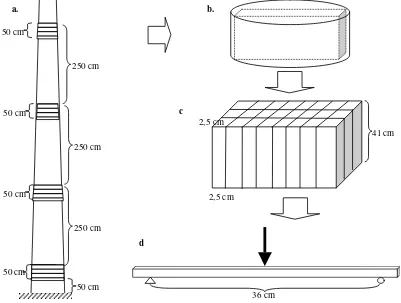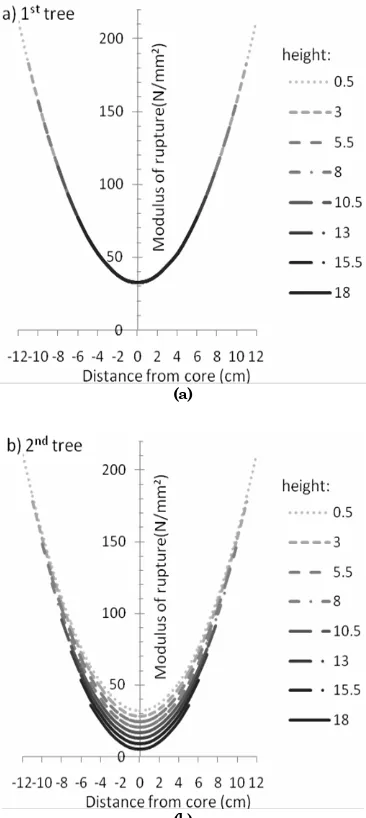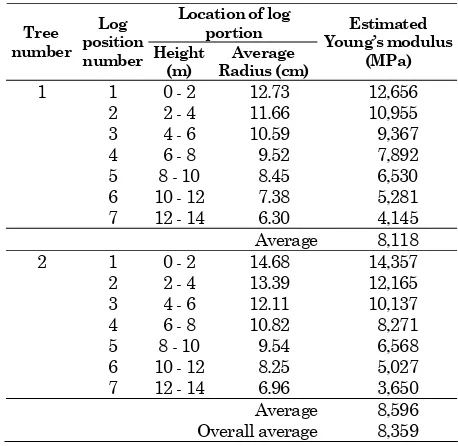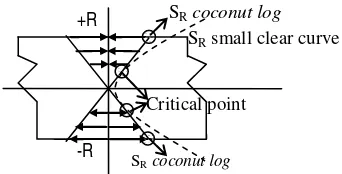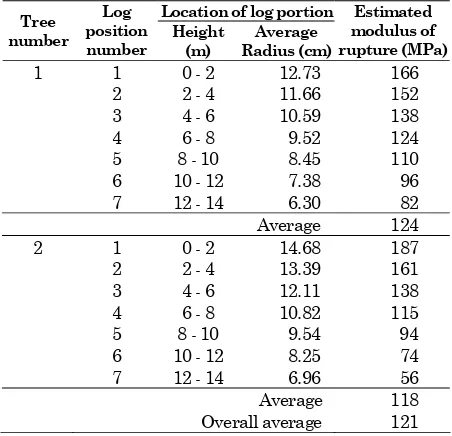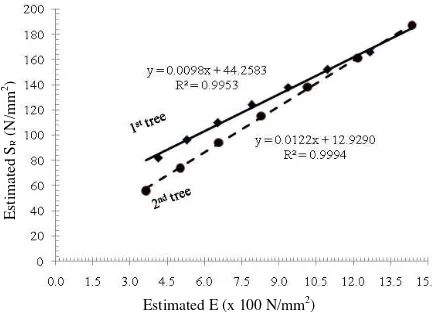Estimating Young’s Modulus and Modulus of Rupture of Coconut
Logs using Reconstruction Method
Bahtiar, E.T.1), Nugroho, N.1), Surjokusumo, S.2)
Abstract: This research develops a theory of the so called reconstruction method to estimate the Young’s modulus (E) and modulus of rupture (SR) of coconut logs. The reconstruction method includes among others; flexure test on small-clear specimens, which were taken from locations distributed along the horizontal as well as vertical direction inside the logs. Further, the estimated E and SR were acquired by arranging systematically each of the small clear specimens as if back in the original location in the logs. The estimation was assisted by mechanical theory, statistics (best fit multiple regression equations), mathematics (calculus), and geometry approach. This reconstruction method successfully estimates E and SR of the coconut logs. The average estimated E and SR value as acquired from tree sample number 1 and 2 were 8,118– 8,596 MPa, and 118–124 MPa, respectively. Those two values were still comparable to common US wood species used for construction i.e. 6,660–15,000 MPa (for E); and 58–132 MPa (for SR). Moreover those estimations of E and SR correlated significantly with each other. This again strengthens the reliability and representativeness of the E and SR values for coconut logs as acquired using the proposed reconstruction methods.
Keywords: coconut logs, modulus of rupture (SR), reconstruction methods, Young’s modulus (E).
Introduction
The Term “coconut wood” or “coco wood” is commonly used for expressing coconut stem; however it is not suitable to put coconut wood in wood material category, because it has special anatomic structure. As a member of Palmae (Arecaceae) family, coconut tree doesn’t have cambium, so it doesn’t grow secondary, to horizontal direction. The geometry of stem is tapered and more perfect cylinder than conifer or deciduous trees. Coconut tree has one stem only without any trunk, and the stem doesn’t have ray cells. The natural characteristics of coconut tree during its growth cause coconut beam and plank free from knot. Because of its specific characteristic, coconut wood has very different properties than softwood or hardwood.
Coconut tree is a tropical plant which grows naturally at the wide range from the beach until mountain, or is planted by people on the farm or garden. It can be found almost everywhere in Indonesia. People plant coconut tree mainly to crop fruit and process it into copra. Coconut tree could produces fruit through the years.
1 Forest Products Department, Bogor Agricultural University, Bogor 16680. Indonesia.
Email: [email protected].
2 Civil Engineering Department, Pakuan University, Bogor 16001. Indonesia
Note: Discussion is expected before November, 1st 2010, and will be published in the “Civil Engineering Dimension” volume 13, number 1, March 2011.
Received 6 March 2009; revised 4 October 2009; accepted 12 March 2010.
The productive period is until 50 years old. After 50 years old the productivity slows down, so it should be replanted. According to the Central Bureau of Statistics (BPS) [1] there are 3.7 million hectares of coconut farms in Indonesia consisting of 94,900 hectare intensive farm and 3.6 million hectare of traditional farm. About 25% of the area comprise old plantations and need to be replanted. Because of its huge quantity, the old coconut wood from non-productive area is very potential for building material or other beneficial purposes.
Coconut wood has become a very useful material since a long time ago. Many villagers use coconut wood to build their house, emergency bridges, or produce handicrafts. They often use coconut wood as poles, beams, or planks. Extensive researches measuring mechanical properties of coconut wood have been done recently, but all of them are mostly confirmed to small clear specimen beam, or plank properties [2-6]. Intensive research on coconut logs properties was so far never held.
Young’s modulus, and modulus of rupture were highest on the coconut stem base at the edge portion, while the lowest, at core portion on the stem top.
Since the sawing of coconut logs to beam or planks will remove the edge part which reveals the best (strongest) properties, some engineers prefer to use the logs in pole form than to use in beam or plank forms for particular construction purpose such as emergency bridge. For these reason, mechanical properties of Coconut logs must be available for reliable building design and other construction purposes. It is important to explore the mechanical properties (e.g. the Young’s modulus and modulus of rupture) of coconut logs directly by full scale testing. Unfortunately, such implementation is not suitable in Indonesia because it is very expensive and needs huge-size as well as high power capacity devices. Adjusting the small clear specimen testing result by size factor to estimate the mechanical properties of coconut logs is not suitable because it has specific characteristic. Size factor as stated on ASTM D245 [9] is specified because more growth characteristics effects on full size than small clear specimens of wood. The condition doesn’t match with coconut log which is free of knots, nearly cylinder, arranges symmetrically from core to edge on both side, and has no ray cells. In order to estimate the mechanical properties of coconut logs, the reconstruction
methods should be conducted through the testing on numerous representative small clear specimens. This paper discusses the reconstruction which has been done on coconut logs to estimate their mechanical properties comprising Young’s modulus and modulus of rupture.
Material and Methods
Two old coconut trees (about 40 year) originated from Leuwiliang, Bogor, West Java Province, were cut down for these research. Those two trees (designated as sample number 1 and 2) were each cut to disk about 50 cm thick. The first disk of each tree was cut 50 cm above its base; the next disks were cut in stages every 250 cm upward until the top of the tree stem. (Figure 1a and 1b). Starting from the stem base, the small clear specimens for the flexure test were prepared from the East edge of each disk moving horizontally every 2.5 cm distance toward the West edge. (Figure 1c). The specimens which are taken from East edge denoted by negative (-) value; and the specimens which are taken from West edge denoted by positive (+) value. It is important to give different sign for the sample prepared from East edge and West edge because the stem has different visual appearance. Coconut trees cork commonly have darker color in East side than West side.
50 cm 50 cm
250 cm 50 cm
250 cm 50 cm
250 cm 50 cm
2,5 cm 2,5 cm
41 cm
36 cm
a. b.
c
d
The preparation of the specimens for all the above disks at a particular tree stem heights was conducted similarly. The dimension for each specimen measured 2.5 cm x 2.5 cm x 41 cm. Young’s modulus and modulus of rupture were tested with center-point loading configuration (flexure test) in accordance with the ASTM D143 [10] procedures. (Figure 1d). Before flexure testing, air drying process is conducted to the specimens in order to adjust the moisture content to approximately 12–15%.
The total number of specimen prepared from those two selected coconut trees there were 103 samples (small clear specimens). Those 103 specimens were tested in flexure, and their Young’s modulus and modulus of rupture measured. In order to determine the distribution of Young’s modulus and modulus of rupture along the horizontal and vertical direction, multiple regression models were introduced under the equation:
Yijk= a+bri+cri2+dtj+etjri+ftjri2+gzk+hzkri+lzkri2+mzktj+ nzktjri+pzktjri2+εijk (1)
which:
Yijk (MPa) : Young’s modulus, E, or modulus of rupture, SR, at the ith distance from the core, jth height from the base, and kth tree number
a : constant (intercept)
b, c, d, e, f, g, h, l, m, n, and p: regression coefficient
ri (cm) : distance of small clear specimen location in the tree stem moving horizontally from the core. If the specimen is prepared from the core ri is 0. If the specimen is from the East side or West side it is –ri or + ri, respectively.
tj(m) : height location of the disk from the stem base where the specimens were prepared
zk : dummy variable whereby zk=0 for the coconut tree number 1; and zk=1 for coconut tree number 2.
εijk : error for each sample at the ith distance from the core, jth height from the base, and kth tree number
The intercept (a) and regression coefficients (b, c, d, e, f, g, h, l, m, n, p) of the multiple regression (Equation 1) were calculated using least square method. To determine the best-fit multiple regression equation, a stepwise regression approach was employed. After the best-fit equation could be determined, together with the calculated intercepts and regression coefficients, all the coordinate data, which revealed the locations of specimens in the tree stem (designated by the horizontal distances from the core as r and by heights from the base as t) and dummy variable indicating sample tree number (z), were incorporated into the equation. Further through mechanics assessment, statistical and calculus analysis, and geometric analytical approaches the most reliable estimate data of the coconut-log mechanical properties could be obtained.
Results
Young’s Modulus
The best-fit regression equation of the Young’s modulus (E) can be obtained as:
E = 4,423-848z+89.5r2-188t;
(n=103; R2= 0.7258; p<0.01) (2)
Further, by incorporating the coordinate data (r, t, and z) into Equation 2, could be obtained a scatterplot (Figure 2). The unit of E is MPa, r is cm, and t is meter. Notation negative (-) and positive (+) on distance from the core (r) represent that the specimens were prepared from East edge and West edge, respectively.
(a)
(b)
Figure 2(a) and 2(b) are scatter plots of distribution data of Young’s Modulus of small clear specimen which are prepared from tree number 1 and 2, respectively. Each graph is drawn by inputting dummy variable value (0 for tree number 1, and 1 for tree number 2) into Equation 2.
Modulus of Rupture
The best-fit regression equation for the modulus of Rupture (SR) is as follows:
SR = 32.74+1.298r2-1.564zt;
(n=103; R2 =0.7279, p <0.01) (3)
The unit of SR is MPa, r is cm, and t is meter. Similar to the case of Young’s modulus, by incorporating the coordinate data (r and t) and dummy variable (z) into Equation 3 could be obtained a scatter plot (Figure 3).
(a)
(b)
Figure 3. The scatterplot revealing the distribution data of modulus of rupture (SR) of the coconut wood log, at various
distance from the log core and at different heights from the stem (log) base; (a) Tree number 1, (b) Tree number 2.
Discussion
Young’s Modulus
Elasticity implies that deformations produced by stress within proportional limit are completely recoverable after loads are removed. When loaded to higher stress levels beyond proportional limit, plastic deformation or failure occurs. Because of its orthotropic nature, wood and other lignocellulosic fiber stuffs (i.e. bamboo, palmae, and other monocotyledonae) have three Young’s modulus, along the longitudinal, radial, and tangential axes which are denoted by EL, ER, and ET, respectively. This modulus should be obtained from compression tests; however, these tasks are rarely performed. The Young’s modulus along the grain (longitudinal) direction or in other word modulus of elasticity (EL) determined by the flexure test rather than by the compression test is the most common way for such testing. The EL through the flexure test included an effect of horizontal shear deflection, so for flexure testing based on ASTM D143 in which the length to height ratio (L/h) approximately 14, EL should be corrected upward by 10% to account for the shear effect. [11,12]. The multiple regression (Equation 2) after being corrected becomes:
EL = 4,865-933z+98.5r2-207t;
(n=103, R2=0,7258, p <0.01) (4)
That multiple regression (Equation 4) in quadratic form which is based on best fit regresion procedure turn out to be the most suitable to estimate the Young’s modulus of small clear specimens prepared from coconut logs. Further by incorporating the coordinate data, i.e. distance from the log core (r), height from the stem base (t), and sample tree number (z) into the Equation 4, could be estimated Young’s modulus (EL) of the coconut wood logs. The curve is almost symetrical to the y axis (Figure 2, after accounting for 10% upward correction). This means that the distribution of Young’s modulus of the wood portion in the West side of the log is almost similar to that in the East side, implying that the geometry of coconut tree viewed from cross-sectional area is almost completely circular. In other words each wood portion in both tree samples (tree number 1 and 2) obtained from similar height (from stem based) and similar distance (from log core) exhibits almost similar Young’s modulus. On both coconut trees, sunlight direction and intensity as received everyday are almost similar; and moreover those trees grew on flat farm area. In this way, therefore, the Young’s modulus (EL) of wood portion in one tree did not differ significantly from the corresponding EL in the other tree.
log. The Young’s modulus ranged from 2,000 to 11,600 MPa (for tree number 1) and 1,200 to 14,300 MPa (for tree number 2). The highest is on the edge and the lowest is on the core. Samples which are cut from the top have lower Young’s modulus than the base.
The main idea to estimate the Young’s modulus of the coconut log is illustrated in Figure 4.
-R
R
Figure 4. Coconut logs on compression testing
Figure 4 shows coconut log, which has a radius (R) and length (L), compressed with center load (P). The center load is distributed over a very stiff and rigid material as it touches the surface of the coconut log. Because of load application, the coconut log will deform an amount of ∆L. The strain (ε) can be
Further, the Young’s modulus (E) of each thin ring could be expressed as:
L
Substituting Equation 4 into Equation 8:
dr
Substituting Equation 9 into Equation 10:
∫
After integration:
207t
Coconut tree is not purely cylinder, but it has a taper. The radius of the top part is smaller than the base part. The relationship between height (in meter) and radius (in cm) of the 1st tree is:
R1 = 13.267 – 0.536t (13)
and the 2nd tree is:
R2 = 15.321 – 0.643t (14)
Finally, substituting Equation 13 into Equation 12, and replacing z with 0, Young’s modulus of coconut logs of tree number 1 is:
EL = 4,865 + 49.25(13.267 – 0.563)2 – 207t (15)
Substituting Equation 14 into Equation 12, and replacing z with 1, Young’s modulus of coconut logs of tree number 2 is:
EL = 3,932 + 49.25 (15.321 – 0.643t)2 – 207t (16)
If the log is cut in two meter lengths, the Young’s modulus of each length can be calculated as shown in Table 1. The estimated Young’s modulus of coconut logs varies between trees. The average Young’s modulus value for tree number 1 and 2 is 8,118 MPa and 8,596 MPa, respectively. The value is three to four times higher if logs are cut near the base than the top.
Table 1. Estimated Young’s modulus of coconut logs cut from 1st and 2nd tree
Location of log portion Tree
number Log position number Height
(m) Overall average 8,359
Modulus of Rupture
maximum load carrying capacity of a member in bending and is proportional to maximum moment borne by the specimen [12].
The distribution of modulus of rupture of coconut wood portions (small clear specimens), along the horizontal and vertical direction in the stem log was similar to that of the Young’s modulus. Besed on best fit multiple regression procedures, Equation 3 was the most suitable to estimate the modulus of rupture of the coconut wood portion along horizontal and vertical direction inside the log. The coefficient of determination of Equation 3 is significant (R2 = 0.7279). The modulus of rupture value based on the test over small clear specimen was 32–133 MPa and 13–182 MPa for coconut tree number 1 and 2, respectively.
As seen on Figure 3, the modulus of rupture of each tree is symmetric with respect to ordinate axis (y). It means the modulus of rupture of small clear specimen which is prepared from East edge of coconut wood is similar with the West edge. Although the visual appearance of the coconut stems cork is commonly darker color at East side than the West side, the modulus of rupture is similar if the specimen is cut from the similar distance (from the log core) and similar height.
Particularly, for tree number 1, the modulus of rupture distribution curves even coincide as shown in Figure 3(a). It means the vertical position, where the sample is prepared from, does not significantly effect the modulus of rupture. The samples which is prepared from tree number 1 have similar modulus of rupture if they are cut from similar distance measured from the core although they were cut from different height in the log. It is proven by zero value of d regression coefficient in Equation 1. The height position gives significant influence into the modulus of rupture of small clear specimen which is prepared from three number 2. This different phenomenom happened because tree number 2 has bigger diameter and more tappered than tree number 1. It is guessed that tree number 2 grew on better site than tree number 1. It will need longer time to harden the vascular bundles of the stem if the diameter is bigger. The vascular bundles of tree no 1 is more uniform in distribution and size than tree no 2. Vascular bundles plays major contribution into the strength properties of coconut stem.
In order to estimate the modulus of rupture of coconut logs, the model shown in Figure 5 is elaborated. Figure 5 shows coconut log applied by uniformly distributed load on bending. Because of the bending moment, normal stress rises from the minimum in the neutral axis until the maximum toward the edge portion of the log. The normal stress
(σ) at particular vertical location (r) in the log can be estimated by:
I Mr
=
σ (17)
Where:
σ = Modulus of Rupture
M = Moment
r = location in vertical distance from the neutral axis
I = moment of inertia
Coconut logs will be strong enough if the load (P) applied is within proportional limit. The first failure occurs if the normal stress at one of its fibers has the same value as its strength. The point of contact between normal stress and fiber strength is critical point. In more detail the situation is described in Figure 6.
r
Neutral axis +R
-R
Modulus of Rupture (SR)
Modulus of Rupture (SR) Normal
stress
Normal stress
(a)
(b) (c)
Figure 5. Uniformly distributed load on bending was applied to coconut log
+R
-R
SR small clear curve
Critical point SRcoconut log
SRcoconut log
Figure 6. Modulus of rupture of small clear specimen curve which is plotted together against normal stress
By definition, modulus of rupture is the maximum load-carrying capacity of material. It can be defined as the maximum normal stress (σmax), when the first failure occurs. Maximum stress happens at the farthest vertical position from the centroid (neutral axis); it is denoted by arrow in Figure 6, so it comes up as:
I MR
= max
σ (18)
Critical point, which is showed on Figure 6, can be calculated if both conditions bellow are fulfilled: 1. At critical point, modulus of rupture of small
stress happens to coconut log. It can be expressed
Substituting Equation 3 and 17 into Equation 19 gives:
32.74 + 1.298 r2critic – 1.564 zt - =0
I Mr
critic (20)
2. Normal stress and modulus of rupture curve coincide at the critical point, so they have the same slope at the point of contact. The suitable mathematical equation through first order derivation for this condition is:
0
The critical point can be estimated by substituting Equation 22 into Equation 20:
0
Equation 22 is quadratic equation which can be solved to become:
1.205zt
Inputting dummy variable (z) into Equation 24, the critical point for the tree sample number 1 is ± 5.02
As mentioned at first condition, the normal stress at the critical point (σcritic) should have the same value as modulus of rupture of small clear specimen on the point of contacts, so it can be calculated by substituting Equation 24 into Equation 3.
3.128zt
A linear curve passes through center point (0, 0) and critical point (rcritic, σcritic) should be normal stress curve when the first failure occurs (Equation 17), and the slope (M/I) could be calculated:
1.205zt
Modulus of rupture for each coconut log can be calculated by substituting Equation 28 into Equation 18:
Replacing dummy variable (z) with 0 and substituting Equation 12 to Equation 29, the modulus of rupture of coconut logs which are cut from the first tree is:
)
The modulus of rupture of coconuts logs which are cut from the second tree can be calculated by replacing dummy variable (z) with 1, and substituting Equation 13 into Equation 29:
0.643t)
Based on Equation 30 and Equation 31 the estimated modulus of rupture of each log which is cut from the first and second tree is shown in Table 2.
According to the reconstruction method, average modulus of rupture of coconut logs which are cut from the first tree and second tree is 124 MPa and 118 MPa respectively. The estimated modulus of rupture and Young’s modulus reveal similar tendency. The coconut logs which are cut from lower position of its tree stem will have higher modulus of rupture and Young’s modulus and vice versa. Therefore the properties should have a high and significant correlation between them. The scatter plot between E and SR is shown in Figure 7. The regression equation between modulus of rupture and Young’s modulus of logs which are cut from the first tree is:
SR = 0.0098E+44.2583; (n=7, R2=0.9953, p<0.01) (32)
and from the second tree is:
SR = 0.0122E+12.9290; (n=7, R2=0.9994, p<0.01) (33)
Because of the significant correlation coefficient, it is reasonable to estimate the modulus of rupture of each log using Equation 32 and Equation 33 for first tree and second tree respectively, besides using Equation 30 and 31.
Table 2. Estimated modulus of rupture of coconut logs cut from 1st and 2nd tree
Est
im
at
ed
SR
(
N/
m
m
2)
Estimated E (x 100 N/mm2)
Figure 7. The relationship between modulus of rupture and Young’s modulus of coconut logs.
The estimated Young’s modulus of coconut logs is 8,118 to 8,590 MPa, and for modulus of rupture is 118–124 MPa, are still comparable to those of common United States wood used for construction (i.e. the Young’s modulus = 6,660–15,000 MPa, and modulus of rupture = 58–132 MPa), as obtained also through bending test [13]. This implies that the result estimate of Young’s modulus and modulus of rupture of the coconut wood log as obtained through the reconstruction method can be regarded reliable and representative.
Conclusion
The reconstruction method which has been developed can successfully estimate the mechanical properties of coconut logs, i.e. Young’s modulus (E) and modulus of rupture (SR). The method incorporated among others the bending (flexure) test, mechanical theory, statistics (best fit multiple regression), mathematics (calculus) and geometry approach.
The acquired estimates of E and SR for coconut logs range about 8,118 to 8,596 MPa and 118 to 224 MPa respectively. Those two estimates are still comparable to those of common US wood species for construction purpose, i.e. 6,600 to 15,000 MPa (for E) and 58 to 132 MPa (for SR). Moreover, those experimented estimation of E and SR correlated significantly which each other. This implies the reliability and representativeness of the reconstruction method in estimating E and SR of coconut logs.
References
1. Biro Pusat Statistik, Statistik Indonesia 2002,
Jakarta, 2002.
2. Kloot, N.H., Mechanical and Physical Properties of Coconut Palm, Australian Journal of Applied Science, 3 (4), 1952, pp. 293–323.
3. Meylan, B.A., Density Variation Within Cocos Nucifera Stems, New Zealand Journal of Forestry Science, 8(3), 1978, pp. 369–383.
4. Ghose, M. and Johri, B.M., Anatomy of Stems of Seedling Palms, Proceedings of the Indian Academy of Science, Plant Sciences, 100(4), 1990, pp. 215–223.
5. Aragon, C.T., Coconut Program Area Research Planning and Prioritization, Philipine Institute for Developments Studies, Los Banos, Phillipines, 2000.
6. Tomlinson, P.B., The Uniquenes of Palms,
Botanical Journal of the Linnean Society, 151, 2005, pp. 4–14.
7. Rahayu, I.S., Sifat Fisik, Mekanis, serta Keawetan Batang Kelapa Hibrida (Physical and Mechanical Properties, and Durability of Hybrid Coconut Wood), Journal Ilmu Pertanian Indonesia, 2 (1), 2006, pp. 24-30.
8. Wardhani, I.Y., Kajian Sifat Dasar Kayu Kelapa (Coconut Wood Properties), Dissertation, Bogor Agricultural University, Bogor, 2005.
9. American Society for Testing and Material,
Standard Practice for Establishing Structural Grades and Related Allowable Properties for Visually Graded Lumber, Designation D245–00, Philadelphia, PA, 2005.
10.American Society for Testing and Material,
Standards Test Methods for Small Clear Specimen of Timber, Designation D143–94, Philadelphia, PA, 2005.
11.Bodig, J. and Jayne, B.A., Mechanics of Wood and Wood Composites, Van Nostrand Reinhold Company, USA, 1982.
12.Forest Products Laboratory, Wood Handbook: Wood as Engineering Material, Forest Products Laboratory USDA Forest Service Agricultural, 1999.
